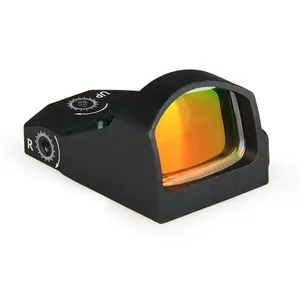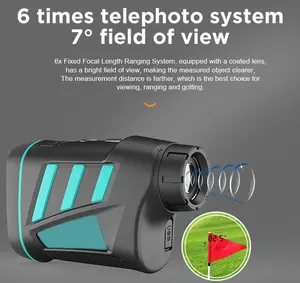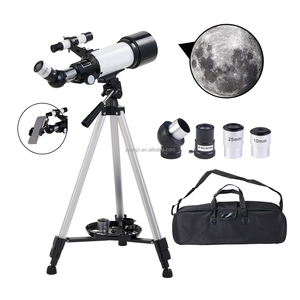A spotting scope is a high-powered optical instrument designed for land-based observation. It surpasses binoculars in magnification, offering detailed scrutiny of far-off subjects. Spotting scopes are indispensable in pursuits such as birdwatching, wildlife monitoring, landscape appreciation, and surveillance tasks. They boast a plethora of attributes, including water resistance, adjustable magnification, and camera adaptability, making them indispensable to both hobbyists and experts. Delve into Alibaba.com's assortment of spotting scopes to discover one that aligns with your observational pursuits.
Types of Spotting Scopes
Spotting scopes are available in diverse configurations, each suited to particular requirements and settings. Angled spotting scopes, with their elevated eyepieces, facilitate prolonged observation without strain, while straight spotting scopes are optimal for swift target location due to their alignment with the viewer's sightline. Compact models cater to the mobile nature of hikers and travelers, whereas larger variants offer superior magnification and expansive views for static use. Each model integrates design features to accommodate various viewing scenarios and user predilections, ensuring a suitable spotting scope for every need. Moreover, certain scopes come with reticles for distance gauging, a feature especially useful in shooting sports and wildlife conservation.
Structure and Operation of Spotting Scopes
The architecture of a spotting scope is a testament to optical craftsmanship. Its principal parts include the eyepiece, focusing mechanism, zoom lens, objective lens, and frequently, a tripod mount. The eyepiece presents the enlarged image, and may be fixed or zoom-capable, offering a spectrum of magnification levels. The focusing mechanism refines the image's sharpness across different ranges. The zoom lens is pivotal for altering magnification without repositioning the scope. The substantial objective lens plays a key role in light collection, crucial under dim conditions. These elements synergize to yield a vivid, magnified portrayal of distant entities. Their operation is typically seamless and user-friendly, permitting swift adjustments in the field, which is vital for following moving targets or alternating focal points.
Materials and Their Properties
The selection of materials for constructing a spotting scope is essential for its efficacy and durability. Lenses are crafted from optical glass with specialized coatings to maximize clarity and light transmission. The chassis is usually composed of aluminum or its alloys, striking a balance between robustness and weight. Rubber or neoprene armoring not only enhances durability and impact resistance but also affords a secure grip. Internal mechanisms may employ stainless steel and other metals for their anti-corrosive and wear-resistant properties. These materials are chosen to brave the elements and deliver a steadfast, superior optical device. The attributes of these materials, such as the scratch resistance of optical glass or the corrosion resistance of stainless steel, are crucial for preserving the scope's performance under various environmental conditions.
Business Usages and Applications
In commercial settings, spotting scopes prove invaluable across various sectors. Land surveyors rely on them for precise observations, while wildlife managers and researchers use them for non-intrusive animal studies. Security forces and law enforcement agencies deploy high-powered scopes for surveillance, ensuring safety from a distance. In maritime contexts, they aid in spotting buoys, vessels, and potential hazards. These scopes underscore their ability to add commercial value by enhancing the precision and efficiency of professional tasks. For instance, in the tourism sector, eco-tourism guides employ premium spotting scopes to enrich nature tour experiences, thereby augmenting educational value and customer contentment.
Functions of Spotting Scopes
A spotting scope fulfills specialized roles that necessitate the magnification of remote objects. It can track a soaring bird, observe wildlife habits, or survey a landscape. The adjustable magnification enables users to either zoom in for intricate details or zoom out for a broader perspective. Many scopes also feature a dual-focus system, allowing for both swift and meticulous image adjustment. Thus, the functionality of a spotting scope is characterized by its capacity to deliver crisp, magnified views at varying distances. Some models are also equipped with illuminated reticles, beneficial in dim lighting or when the target lacks contrast.
Distinctive Features of Spotting Scopes
The distinctive attributes of a spotting scope encompass its sturdy build, premium optics, and specialized coatings that elevate image fidelity. Models that are waterproof and fog-proof demonstrate resilience in adverse weather. Certain scopes offer interchangeable eyepieces for varied magnification levels. Features such as a sunshade, to diminish glare, and a rotating tripod collar, for adaptable positioning, distinguish these scopes from their counterparts. The latest iterations may also integrate cutting-edge elements like integrated laser rangefinders, image stabilization, and even inbuilt cameras for direct image capture through the scope.
Benefits of Using a Spotting Scope
The advantages of employing a spotting scope are manifold. Bird enthusiasts can observe avian life closely without causing disturbance. Hunters are able to scout terrain and identify game from afar. For marksmen, it facilitates the identification of shot placements at extended distances. The scopes also cater to the demands of nature aficionados and researchers by providing intricate views of the environment. The outcomes include heightened enjoyment, bolstered safety, and increased success in various outdoor activities. In educational contexts, spotting scopes bring the wonders of the natural world into closer perspective for students, fostering a richer comprehension and appreciation of biological and ecological sciences.
How to Choose the Right Spotting Scope?
In choosing a spotting scope, contemplate its intended application, be it birdwatching, hunting, or other pursuits. Opt for suitable magnification, a broad field of vision, and high-caliber optics. Selecting waterproof and fog-proof models is imperative for outdoor activities. Also, evaluate compatibility with tripods and additional accessories for a comprehensive viewing setup. The scope's weight and dimensions are critical considerations, particularly for those who intend to transport it. The type of eyepiece is another factor; angled eyepieces are preferable for stationary observation, whereas straight eyepieces are better suited for active scenarios.
How to Maintain and Care for Your Spotting Scope?
To maintain a spotting scope, regular lens cleaning with proper tools is advised, as is storage in a protective case and cautious handling to prevent falls and impacts. Periodic inspections for alignment and functionality will prolong the scope's life and maintain its performance. It is also wise to avoid exposing the scope to extreme temperatures and to clean it following contact with saltwater or dust. Employing lens caps when not in use will shield the optics from scratches and contaminants.
How to Install and Use a Spotting Scope?
Setting up a spotting scope typically entails affixing it to a tripod and calibrating the focus and magnification to suit the conditions. For digiscoping, connect the camera adapter and align the camera's lens with the scope's eyepiece. Acquaint yourself with the scope's functionalities and adjustments to fully leverage its capabilities. When utilizing the scope, begin with the lowest magnification to locate the subject, then incrementally increase the power. Ensure the tripod's stability and modify the eyecup for comfortable viewing, particularly for spectacle wearers.
Explore the extensive array of spotting scopes on Alibaba.com to find the ideal optical instrument that meets your specific needs and preferences.






























 浙公网安备 33010002000092号
浙公网安备 33010002000092号 浙B2-20120091-4
浙B2-20120091-4